ζ Pup: XMM RGS line-profile analysis
Ne X Lyman-α at 12.134 A
We fit only the RGS2 data (there is very little RGS1 data, due to a camera failure -- the effects of including that additional data are shown in our archive of previous fits).
First we repeat the non-porous fit shown on the main page.
Non-porous: RGS2

|
[11.98:12.18]
vinf = 2250
β = 1
powerlaw continuum, n = 2
norm = 1.44e-3 +/- (1.14e-3:1.74e-3)
q = 0
hinf = 0
taustar = 1.81 +/- (1.59:2.06)
Ro = 1.61 +/- (1.43:1.76)
shift = 0
norm = 3.10e-4 +/- (3.02e-4:3.18e-4)
chisq = 24.04 for N = 19
|
This fit is formally pretty good (chi-sq = 24 for 15 d.o.f).
Compare these results to the analogous model fit to the same line in the Chandra spectrum. There is quite good agreement (taustar values disagree by only about 10%, well within the formal confidence limit range). The same is true for Ro, while the normalizations disagree by about 2-sigma.
Next, we'll fit models with anisotropic porosity assuming flattened, radially oriented clumps. We use the "stretch" porosity length distribution, h(r), parameterized by hinf. We will fit first with hinf a free parameter, and then at fixed values of hinf = 0.5, 1, 2, and 5 R*.
aniso-porous: RGS2, hinf free
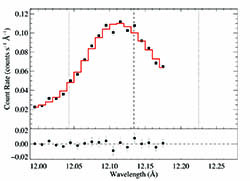
|
[11.98:12.18]
vinf = 2250
β = 1
powerlaw continuum, n = 2
norm = 1.45e-3 +/- (:)
q = 0
hinf = 0.00 +/- (0.00:0.28)
taustar = 1.78 +/- (1.59:3.37)
Ro = 1.62 +/- (1.01:1.77)
shift = 0
norm = 3.10e-4 +/- (3.02e-4:3.19e-4)
chisq = 24.06 for N = 19
|
Note that despite the fact that the terminal porosity length's best-fit value is found to be zero (1e-7 or so, actually), the best-fit model parameters are not identical to the non-porous fit. They are very close, of course, but the small differences are probably due to the numerical integration that's required in the aniso case. Note that the 68% upper confidence limit on hinf is 0.28, and that enables larger values of taustar, and smaller values of Ro, apparently.
Now, a sequence of fits with fixed hinf values of 0.5, 1, 2, and 5.
aniso-porous: RGS2, hinf = 0.5
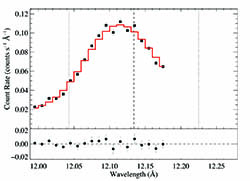
|
[11.98:12.18]
vinf = 2250
β = 1
powerlaw continuum, n = 2
norm = 1.15e-3 +/- (:)
q = 0
hinf = 0.5 (frozen)
taustar = 3.92 +/- (3.25:4.75)
Ro = 1.35 +/- (1.16:1.56)
shift = 0
norm = 3.18e-4 +/- (3.10e-4:3.26e-4)
chisq = 27.27 for N = 19
|
aniso-porous: RGS2, hinf = 1

|
[11.98:12.18]
vinf = 2250
β = 1
powerlaw continuum, n = 2
norm = 9.70e-4 +/- (:)
q = 0
hinf = 1 (frozen)
taustar = 5.99 +/- (:)
Ro = 1.42 +/- (:)
shift = 0
norm = 3.23e-4 +/- (:)
chisq = 34.22 for N = 19
|
aniso-porous: RGS2, hinf = 2
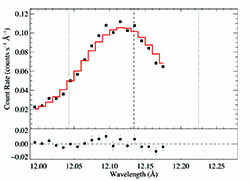
|
[11.98:12.18]
vinf = 2250
β = 1
powerlaw continuum, n = 2
norm = 7.14e-4 +/- (:)
q = 0
hinf = 2 (frozen)
taustar = 12.61 +/- (:)
Ro = 1.46 +/- (:)
shift = 0
norm = 3.31e-4 +/- (:)
chisq = 47.21 for N = 19
|
aniso-porous: RGS2, hinf = 5
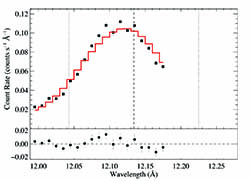
|
[11.98:12.18]
vinf = 2250
β = 1
powerlaw continuum, n = 2
norm = 2.08e-4 +/- (:)
q = 0
hinf = 5 (frozen)
taustar = 64.82 +/- (:)
Ro = 1.35 +/- (:)
shift = 0
norm = 3.44e-4 +/- (:)
chisq = 66.88 for N = 19
|
Summarizing
The effect of porosity and the tradeoff between porosity length and optical depth can be summarized by looking at the joint parameter confidence limits. We show the 68%, 95%, and 99% limits below. The best-fit model is the filled circle.
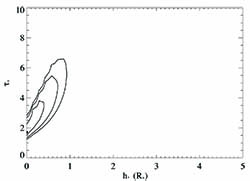
Now, we'll look at models with isotropic porosity.
iso-porous: RGS2, hinf free
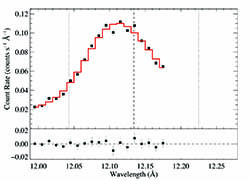
|
[11.98:12.18]
vinf = 2250
β = 1
powerlaw continuum, n = 2
norm = 1.43e-3 +/- (:)
q = 0
hinf = 0.33 +/- (0.00:3.83)
taustar = 1.97 +/- (1.62:8.03)
Ro = 1.61 +/- (1.41:1.77)
shift = 0
norm = 3.10e-4 +/- (3.02e-4:3.18e-4)
chisq = 24.04 for N = 19
|
Note poorly constrained hinf and taustar.
Now, a sequence of fits with fixed hinf values of 0.5, 1, 2, and 5.
iso-porous: RGS2, hinf = 0.5
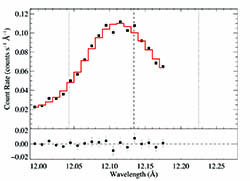
|
[11.98:12.18]
vinf = 2250
β = 1
powerlaw continuum, n = 2
norm = 1.43e-3 +/- (:)
q = 0
hinf = 0.5 (frozen)
taustar = 2.07 +/- (1.80:2.41)
Ro = 1.61 +/- (1.45:1.76)
shift = 0
norm = 3.10e-4 +/- (3.02e-4:3.18e-4)
chisq = 24.04 for N = 19
|
iso-porous: RGS2, hinf = 1
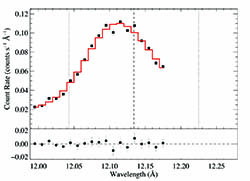
|
[11.98:12.18]
vinf = 2250
β = 1
powerlaw continuum, n = 2
norm = 1.42e-3 +/- (:)
q = 0
hinf = 1 (frozen)
taustar = 2.41 +/- (2.07:2.86)
Ro = 1.61 +/- (1.46:1.76)
shift = 0
norm = 3.10e-4 +/- (3.02e-4:3.19e-4)
chisq = 24.06 for N = 19
|
Note: with hinf = 1, taustar has increased by 33 percent.
iso-porous: RGS2, hinf = 2
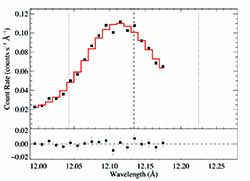
|
[11.98:12.18]
vinf = 2250
β = 1
powerlaw continuum, n = 2
norm = 1.37e-3 +/- (:)
q = 0
hinf = 2 (frozen)
taustar = 3.42 +/- (2.81:4.29)
Ro = 1.60 +/- (1.47:1.74)
shift = 0
norm = 3.11e-4 +/- (3.02e-4:3.19e-4)
chisq = 24.19 for N = 19
|
iso-porous: RGS2, hinf = 5
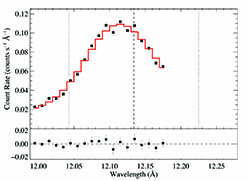
|
[11.98:12.18]
vinf = 2250
β = 1
powerlaw continuum, n = 2
norm = 1.12e-3 +/- (:)
q = 0
hinf = 5 (frozen)
taustar = 12.99 +/- (8.87:19.61)
Ro = 1.58 +/- (1.46:1.71)
shift = 0
norm = 3.16e-4 +/- (3.08e-4:3.24e-4)
chisq = 26.31 for N = 19
|
Summarizing
We show the 68%, 95%, and 99% limits below. The best-fit model is the filled circle.
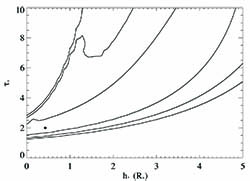
And here is an extensive log of all these xspec fits.
Back to the top
last modified: 10 May 2012












